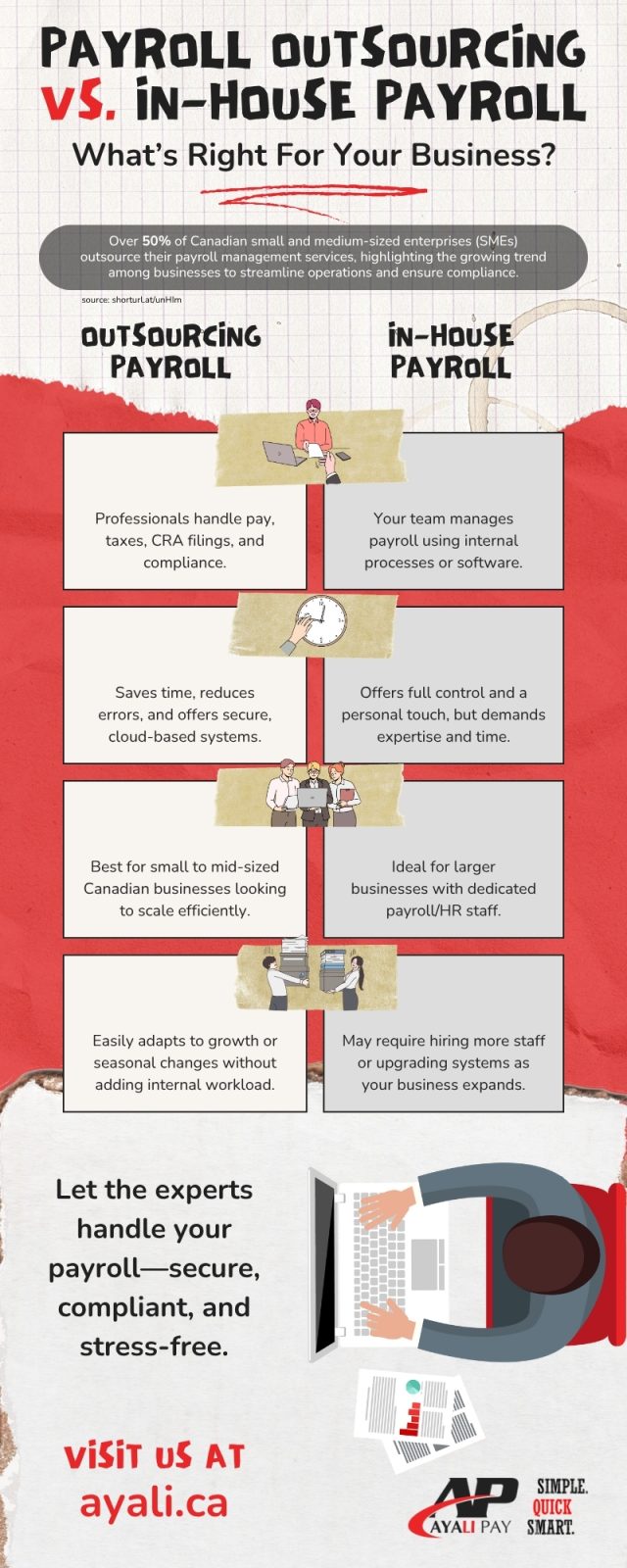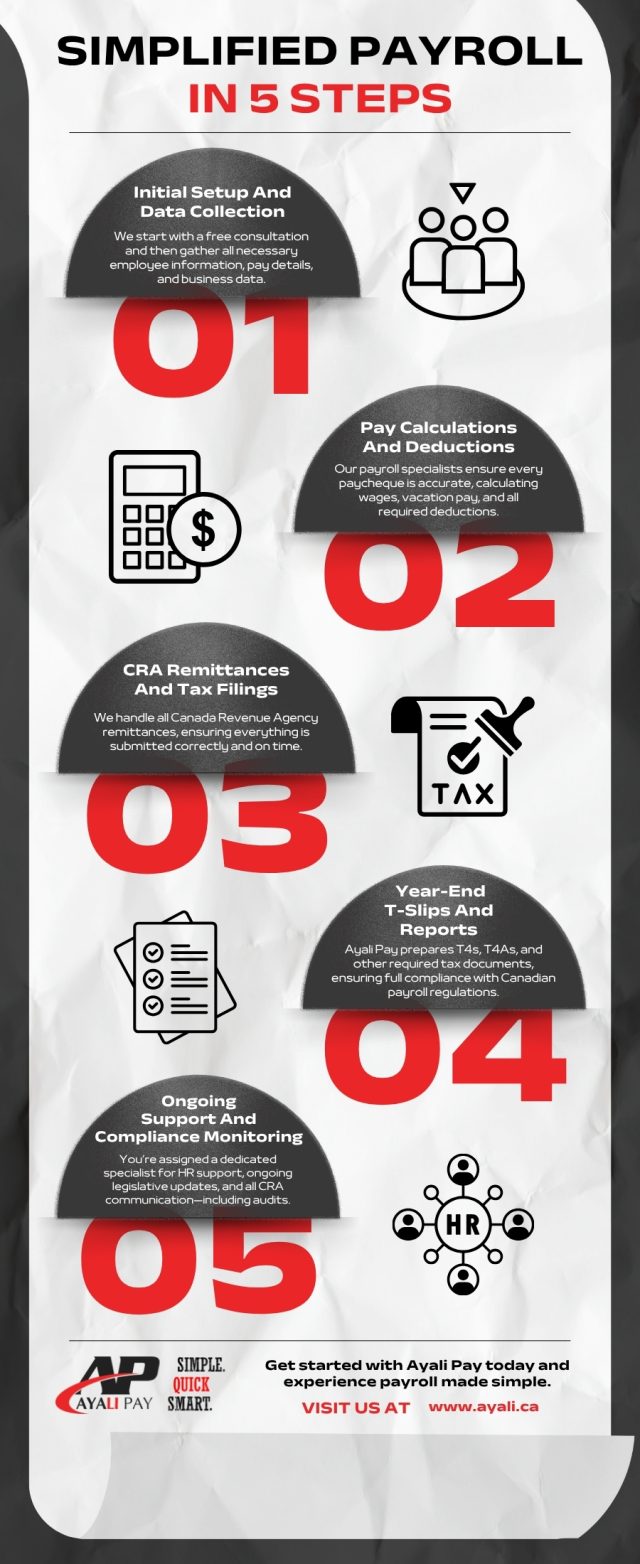Running a business means managing countless moving parts—from operations and HR to compliance and finances. Among these, payroll is a critical area that directly affects your employees and your bottom line. Unfortunately, payroll fraud is one of the most common types of internal fraud in organizations, regardless of size.
In Canada and beyond, businesses must be vigilant about protecting their payroll systems. Thankfully, effective payroll fraud prevention strategies and reliable partners can shield your business from risks. This blog explores how to spot red flags, strengthen internal controls, and secure your payroll with advanced solutions like all-inclusive payroll services in Canada and fully managed payroll systems.
What Is Payroll Fraud?

Payroll fraud refers to the deliberate manipulation of a company’s payroll system to divert funds for unauthorized personal gain. It is a serious and surprisingly common threat that can be perpetrated by employees, payroll personnel, contractors, or even external parties. Because payroll processes involve sensitive data and regular cash flow, they are often targeted by individuals seeking to exploit weaknesses in internal controls.
This type of fraud is particularly insidious because it often goes undetected for months or even years. When it does come to light, the consequences can be far-reaching—leading not only to substantial financial losses but also to damaged employee morale, eroded trust, and even legal consequences for the business, especially if the fraud involves tax misreporting or non-compliance.
Below are some of the most common types of payroll fraud schemes that every employer should be aware of:
• Ghost Employees
In this scheme, fake or “ghost” employees are added to the payroll system—often by someone with access to payroll administration. These phantom employees do not work for the company, but they receive paychecks that are redirected to the fraudster’s personal bank account. This type of fraud is more prevalent in organizations with large workforces or inadequate oversight.
• Timesheet Fraud
Timesheet fraud occurs when employees deliberately record more hours than they worked or manipulate clock-in and clock-out systems to reflect false attendance. In some cases, colleagues may even “buddy punch” on behalf of an absent co-worker. This form of time theft can be difficult to detect without automated tracking systems and careful review of timesheets.
• Commission Fraud
This form of payroll fraud is common in sales-driven organizations where employees receive commissions based on performance metrics. Fraudulent employees may report inflated sales figures, create fictitious clients or orders, or manipulate return and refund data to earn commissions they did not earn. Left unchecked, this can not only skew payroll but also distort business performance metrics.
• Misclassification of Employees
Sometimes, employers may deliberately or accidentally misclassify full-time employees as independent contractors. This misclassification can lead to avoidance of payroll taxes, benefits, and overtime pay—often violating labor laws and putting the business at risk for non-compliance penalties. On the other hand, employees may misrepresent their job classification to manipulate their tax responsibilities or eligibility for benefits.
• Expense Reimbursement Fraud
This type of fraud occurs when employees submit fake, duplicate, or inflated expenses for reimbursement. Examples include falsifying receipts, claiming personal purchases as business expenses, or exaggerating travel-related costs. Without a strict verification process, these fraudulent reimbursements can quietly drain company funds over time.
Red Flags That Suggest Payroll Fraud

Early detection is one of the most powerful tools in your arsenal when it comes to payroll fraud prevention. Spotting red flags at the initial stages can help you mitigate losses, address internal vulnerabilities, and safeguard your business before the situation escalates. Fraudulent activity often starts small but can quickly spiral into significant financial and legal trouble if not caught in time.
While payroll fraud can be cleverly disguised, there are consistent indicators that may suggest something is amiss. As an employer or payroll administrator, it’s crucial to remain alert and investigate anomalies without delay. Below are several common warning signs to watch for:
• Frequent Complaints or Errors in Payroll
If you’re regularly fielding employee complaints about incorrect paychecks—whether it’s underpayments, overpayments, or missing deductions—it may signal deeper issues within your payroll process. Although some discrepancies can result from genuine mistakes, consistent payroll errors could point to deliberate tampering or a systemic weakness being exploited. These recurring problems warrant an immediate review of your payroll system.
• Payroll Records with Duplicate Addresses or Bank Accounts
Duplicate contact details, mailing addresses, or bank account numbers across multiple employee profiles can be a red flag. In some cases, this could indicate the presence of ghost employees or the manipulation of employee profiles to siphon off additional funds into one account. Conduct periodic data audits to ensure that each employee’s information is unique, consistent, and verifiable.
• Employees Receiving Multiple Payments
Unexplained duplicate payments—especially for the same pay period—can indicate fraudulent manipulation within the system. While one-off duplicate payments might be clerical errors, recurring ones should be investigated immediately. Look into the payment history, payroll approvals, and corresponding timesheets to determine whether these disbursements were justified or deceptive.
• Employees Resisting Audits or Reviews
Employees or payroll staff who are defensive or resistant to internal audits, process reviews, or questions about payroll-related activities should raise concerns. While privacy and workload pressures are understandable, consistent refusal to cooperate may suggest they have something to hide. Transparency should be a core value in your payroll operations, and resistance to oversight can be a key indicator of fraudulent behavior.
• A Lack of Segregation of Duties Within Payroll Processing
Segregation of duties is a fundamental internal control in any business, especially when dealing with financial processes. If the same person is responsible for entering payroll data, approving hours, distributing payments, and reconciling records, your business is at high risk for fraud. This consolidation of responsibilities makes it easier for fraudulent activities to go undetected. Implementing role-based access and separating key payroll tasks among multiple personnel or teams is a vital part of payroll fraud prevention and overall payroll compliance.
Being proactive about monitoring and investigating these red flags is critical to the health of your payroll system. When suspicions arise, conduct a thorough payroll audit with the help of internal staff or external professionals. A deep dive into payment records, tax filings, and employee profiles can uncover hidden schemes and help you take corrective actions swiftly.
Best Practices for Payroll Fraud Prevention

1. Strengthen Internal Controls
Strong internal controls are the foundation of payroll fraud prevention. Assign different people to handle various payroll duties—such as timesheet approval, data entry, and paycheck distribution. This limits the chance of one person committing fraud unnoticed.
2. Conduct Regular Audits
Perform both scheduled and surprise audits. Look for inconsistencies, anomalies, or unexplained changes in employee compensation. This reinforces the message that payroll is under close supervision and reduces the opportunity for wrongdoing.
3. Use Technology and Automation
Modern business payroll solutions are equipped with advanced features like biometric logins, automated timesheets, and real-time monitoring. These technologies minimize human error and manipulation, creating a more secure payroll process.
4. Implement Payroll Compliance Policies
Create and enforce a strict payroll compliance policy. Outline clearly defined procedures for employee classification, record-keeping, tax reporting, and compensation. Make sure all payroll staff are trained on these policies and kept updated on legal changes.
5. Partner with Trusted Payroll Providers
One of the smartest moves you can make is partnering with a provider offering all-inclusive payroll services in Canada. These services typically include payroll processing, tax filings, record-keeping, and legal compliance—all handled by experienced professionals. With a fully managed payroll, you reduce the risk of internal fraud while gaining peace of mind.
Benefits of Fully Managed Payroll Services

Switching to a fully managed payroll system ensures transparency, consistency, and adherence to evolving regulations. It also gives you access to:
- Real-time analytics and reports
- Automated tax deductions and filings
- Employee self-service portals
- Strict data encryption and security protocols
With these in place, you’re not only improving efficiency but actively participating in payroll fraud prevention.
Why You Need Business Payroll Solutions in 2025 and Beyond

As cyber threats and internal fraud schemes become more sophisticated, relying on outdated systems can put your business at risk. Business payroll solutions like cloud-based platforms and outsourced services offer better data integrity, regular backups, and compliance with federal and provincial tax laws.
Moreover, outsourced all-inclusive payroll services in Toronto bring in experts who stay ahead of tax codes and HR regulations—relieving you of complex administrative burdens.
Investing in payroll compliance and fraud detection is not just a safety measure; it’s a long-term business strategy.
How Ayali Pay Can Help Your Business
At Ayali Pay, we specialize in payroll fraud prevention through secure, compliant, and customizable solutions. Our all-inclusive payroll services in GTA are designed to meet the unique needs of Canadian businesses, offering:
- Transparent reporting and audits
- Fully automated tax and payment processing
- Scalable fully-managed payroll options
- Complete payroll compliance coverage
- End-to-end business payroll solutions for companies of all sizes
Don’t leave your payroll to chance. Let our experienced professionals secure your systems and streamline your operations.
Ready to protect your business from payroll fraud?
Visit our Online Inquiry & Scheduling Form to contact us and schedule your free consultation today. Discover how Ayali Pay can offer you peace of mind through advanced payroll fraud prevention, compliance assurance, and full-service payroll solutions tailored for Canadian businesses.


































